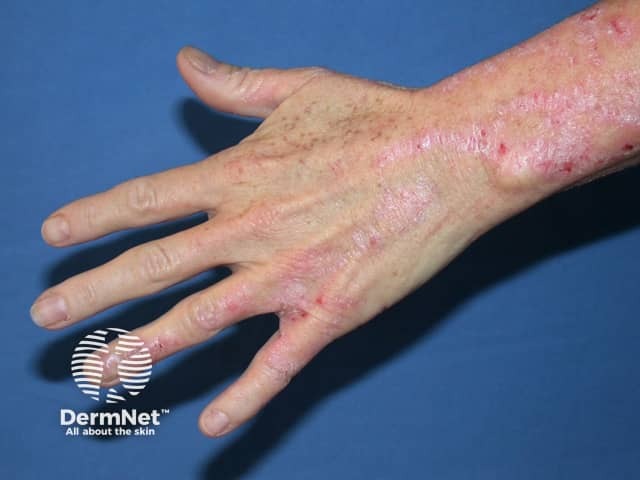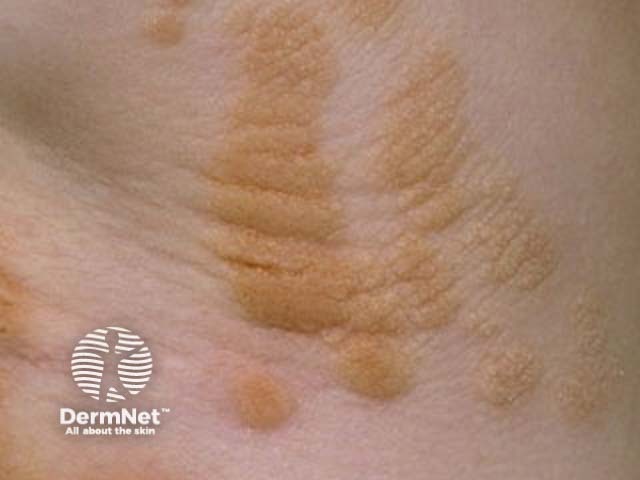Main menu
Common skin conditions

NEWS
Join DermNet PRO
Read more
Quick links
Inflammatory linear verrucous epidermal naevus — extra information
Inflammatory linear verrucous epidermal naevus
Author: Vanessa Ngan, Staff Writer, 2003; minor update by Dr Ian Coulson, Dermatologist (2024).
Introduction
Causes
Demographics
Clinical features
Diagnosis
Treatment
What is an inflammatory linear verrucous epidermal naevus?
An inflammatory linear verrucous epidermal naevus (ILVEN) is a special kind of epidermal naevus. Epidermal naevi are birthmarks due to an overgrowth of the epidermis (upper layers of the skin).
What causes ILVEN?
The abnormality resulting in ILVEN arises from a defect in the ectoderm. This is the outer layer of the embryo that gives rise to epidermis and neural tissue. The defect causing the skin lesions may also result in disorders of other internal organs such as the brain, eyes and skeleton. This is extremely rare with ILVEN. ILVEN is highly heterogenous genetically with mosaic mutations identified in numerous genes, including NSDHL, PMVK, HRAS and CARD14. Many cases do not demonstrate a known genetic mutation.
Who gets ILVEN?
ILVEN may be present at birth, but usually arises during the first 5 years of life and spreads over months or years. It is somewhat more common in females than in males and occurs in all races.
What are the clinical features of ILVEN
Like other linear epidermal naevi, ILVEN is characterised by warty lesions that tend to group together in a linear pattern. The difference is that the lesions are red, inflamed and itchy, sometimes intensely so. The surface of the lesions may look like eczema (dry, red, scratched) or like psoriasis (red and scaly).
ILVEN most often affects one leg and may extend from the buttock to the foot.


Inflammatory linear verrucous naevus

ILVEN

How is ILVEN diagnosed?
ILVEN is diagnosed by careful history and physical examination. A skin biopsy can be helpful and may show the characteristic histological features of ILVEN.
Genetic testing for a variety of mutations (see above) may help elucidate the cause and may help to direct therapy.
What is the treatment of ILVEN?
No curative treatment is available for ILVEN.
- Emollients and low potency topical steroids can relieve the itching.
- Emollients or topical calcipotriol may relieve the dryness.
- Cholesterol and simvastatin cream may be valuable for a minority of cases.
- Ustekinumab may be helpful in those with CARD14 mutations.
References
- Book: Textbook of Dermatology. Ed Rook A, Wilkinson DS, Ebling FJB, Champion RH, Burton JL. Fourth edition. Blackwell Scientific Publications.
- Atzmony L, Ugwu N, Hamilton C, et al. Inflammatory linear verrucous epidermal nevus (ILVEN) encompasses a spectrum of inflammatory mosaic disorders. Pediatr Dermatol. 2022;39(6):903-907. doi:10.1111/pde.15094 Journal
- Polubothu S, Riachi M, Stadnik P, et al. Inflammatory linear verrucous epidermal nevus should be genotyped to direct treatment and genetic counselling. J Am Acad Dermatol. 2024;90(6):1279-1280. Journal
On DermNet
- ILVEN images
- ILVEN pathology
- Birthmarks
- Epidermal naevi
- Becker naevus
- Comedone naevus
- Sebaceous naevus
- Linear porokeratosis
Other websites
- Epidermal Nevus Syndrome — Medscape Drugs & Diseases
